(Justice Traps the Guilty #6 – #8, Headline #33 – #34)
This chapter will cover the Prize crime comics from the period September 1948 until February 1949. Young Romance was also published throughout this period and the first Young Love issue would be cover dated February 1949. Charlie Chan, which featured covers by Jack Kirby and most stories by Carmine Infantino, was also published during this time interval. An important shift seems to have occurred between the material covered here and that from last chapter. Chapter 5 discussed 6 artists with attributions for all the stories. In this chapter there are 10 artists identified but 8 stories remain unattributed so the number of artists was actually higher. The change did not affect Jack Kirby very much, if at all. Jack remains the principal artist; providing all the covers and 6 stories for a total of 77 pages. Kirby supplied all the lead stories and even the illustrations for three text pieces. On the other hand, Bill Draut plays a much more minor roll rendering only 3 stories with 22 pages total. Warren Broderick would do more (4 stories with 30 pages, assuming my attributions are correct). Manny Stallman would tie Draut (3 stories with 22 pages).
There also seems to be a difference between the crime titles and Young Romance during this period. At the same time that Draut’s presence declined in the crime titles he and Kirby were still the main artists for Young Romance. Young Romance #7 (September 1948) to #9 (January 1949) would be drawn by Kirby and Draut alone. Young Romance #10 (March 1949) would also include just one story by artists other then Kirby or Draut (the team of Al Eadeh and John Belfi). This is very different from the multiple artists present in the crime titles. Eventually Simon and Kirby would stop producing crime comics; one of the reasons that I am doing this serial post is to try to determine more precisely when that happened. Simon and Kirby were certainly producing Headline and JTTG during the period covered in this chapter, but the drop of crime stories by Bill Draut may be symptomatic of a change to come.
Because of the number of artists, I am going to bypass some. One to be skipped will be Bill Draut. Draut’s work during this period is pretty much the same as seen previously. Another artist that will be neglected here will be A. C. Hollingsworth. “The Amazing 3 Sinister Salesmen” (JTTG #6, September 1948) will be the last signed work that Hollingsworth would do for Simon and Kirby. So far I have not seen an unsigned work by Alvin so I suspect that Hollingsworth total output for Simon and Kirby was an unremarkable four stories. A surprisingly low number for an artist that Joe Simon still remembers. Finally there are 8 stories that I have not determined an attribution. I presently believe that 4 or 5 different artists are present but I will discuss only one of them.
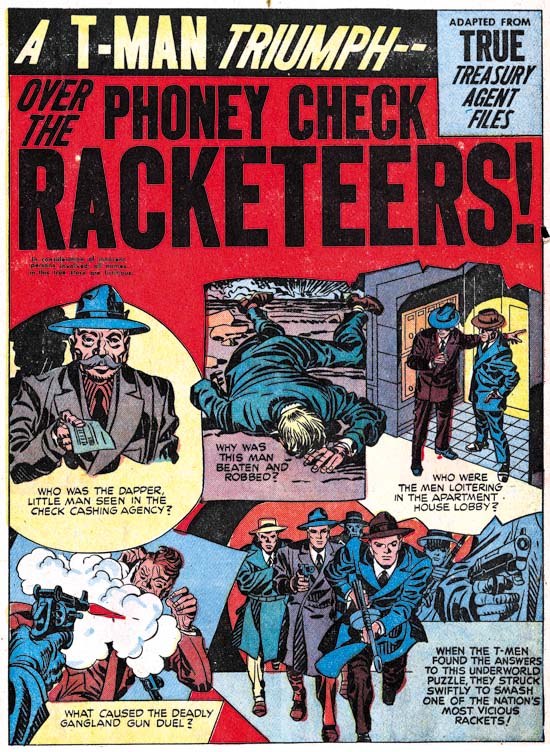
Justice Traps the Guilty #7 (November 1948) “Phony Check Racketeers”, art by Jack Kirby
Most of the lead stories continued to use the motif of a character introducing the story with the speech balloon forming the title. For “Phony Check Racketeers” Simon and Kirby deviated by giving the lead story a splash design they had not previously used for crime comics. The splash actually consists of five vignettes acting as the comic book equivalent of a movie trailer. Four panels ask questions that suggest some of the content of the story while the fifth indicates that the T-Men will find the answers and once again prove that crime does not pay. I do not recall any previous splash that consisted of little more then a series of preview panels but there is some similarity to this splash to one Captain America #9. In any case it is a layout that would rarely be used by Simon and Kirby for their splashes.

Justice Traps the Guilty #6 (September 1948) “The Capture of One-Eye”, splash panel by Jack Kirby, story panels by unidentified artist
I will repeat an observation that I made in my last chapter, Jack Kirby’s crime splashes just no longer have the impact that his early ones had. I find those that Jack was doing at this same time for romance comics much more interesting. However there are occasional exceptions. Kirby certainly provided an interesting splash for “The Capture of One-Eye”. The eye is also by Jack while the story panels, as well as the rest of the story, are by an artist I have not been able to identify. The layout, with its vertical splash and story panel arrangement, is one unusual for Jack. I see no sign of Kirby layouts in this story, so it is possible that the panel layout of the first page was selected by the story artist. But the vertical panel works so well with Jack’s composition that I rather inclined to believe that it was Kirby’s selection despite its otherwise rarity.
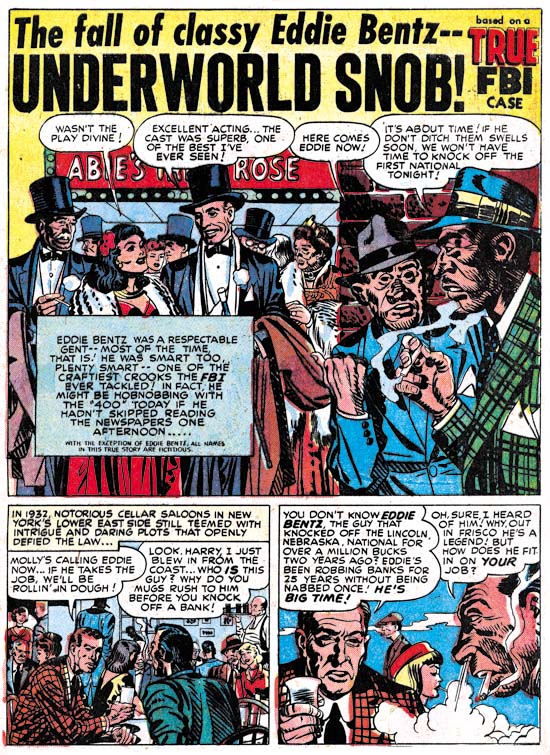
Justice Traps the Guilty #8 (January 1949) “Underworld Snob”, art by Jack Kirby and Warren Broderick
One Kirby crime story stands out from the rest of those of this period. The inker was so heavy handed that it is rather easy to overlook this as one of Kirby pencils. It is very similar to “Mother Said No” (Young Romance #7, September 1948 ). Originally I attributed that inking of that piece questionably to Carmine Infantino. In Chapter 5 I changed my mind and now credit Warren Broderick as the inker. I am now attributing the inking of “Underworld Snob” it Broderick as well. However Joe Simon has described inking of Kirby’s work in the Simon and Kirby studio as being like a production line with different artists helping out. I bring this up because I am not convinced that all the inking was all by Warren. The spotting was done in the typical Studio style inking. More typical then Broderick used when inking “A Gangster Dies” (Headline #31, August 1948) a piece where Warren did a good job of mimicking Kirby’s style.

Justice Traps the Guilty #7 (November 1948) “The Man Who Died Twice”, art by Warren Broderick
There are four stories that I here credit to Warren Broderick, this is more then any other artist other then Kirby. But the catch is that I am not complete sure of the identification. The art is simpler then the examples of Broderick from last chapter. Further there is no danger in mistaking any of it for work by Jack Kirby. But the wild eyebrows that Broderick used occur here as well (although not on the example page shown above) and certain facial expressions are found in both groups. Perhaps Broderick is working with another artist; an arrangement that Warren once had with Harry Harrison.
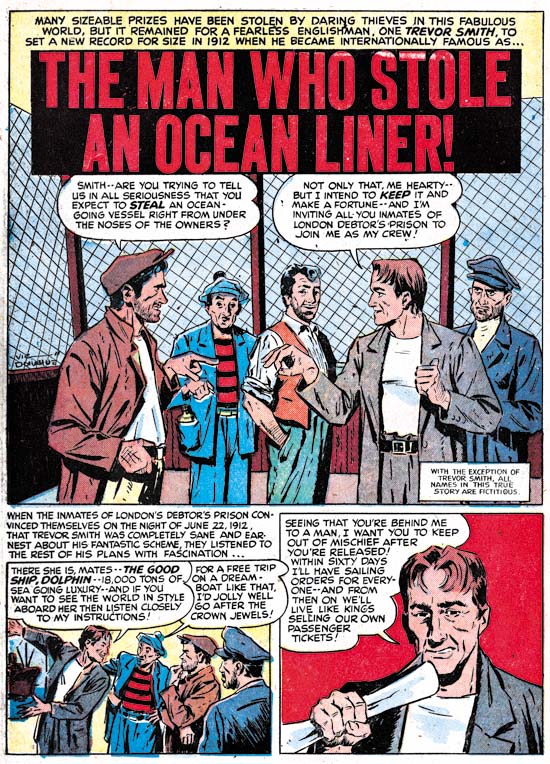
Headline #33 (December 1948) “The Man Who Stole an Ocean Liner”, art by Vic Donahue
“The Mystery of Room 712” (Headline #32, October 1948) was the first work by Vic Donahue for a Simon and Kirby production. Vic also did “The Man Who Stole an Ocean Liner” which I show above. Donahue uses a style that leans toward realism with some panels looking like they were based on photographs. Inking was done with a combination of brush and a pen. We will encounter Donahue in future chapters as well and Vic has already been discussed in the Art of Romance both for work in the western love comics and the more standard romance. As time went on Vic’s work showed less of the careful drawing and fine inking found in his earlier crime stories.

Justice Traps the Guilty #8 (January 1949) “End of a Blackmailer”, art by Manny Stallman
The biggest treat for me in this chapter is Manny Stallman. Stallman is a good graphic story teller with a style that tended toward caricature (or at least for his Simon and Kirby art). Realism is not necessarily a characteristic I look for in comic book art and I find Stallman’s style very appealing. Atlas Tales has a number of examples of his work, but all from a later period (1952 to 1957) and all unsigned. The style is different then Manny used for Simon and Kirby. So different that based on the Atlas material I doubt that I would have recognized Manny’s S&K work had it all been unsigned. But I gather Manny would often change his style. Mark Evanier has a marvelous obituary on Manny Stallman which includes comments by Gil Kane. Kane describes Manny’s inking as “very crude but it worked”. I am very impressed by Stallman’s inking. Not for any show of dexterity, but for the impact the inking provided. Particularly well done are his panels dominated by black such as the last one in the image above.
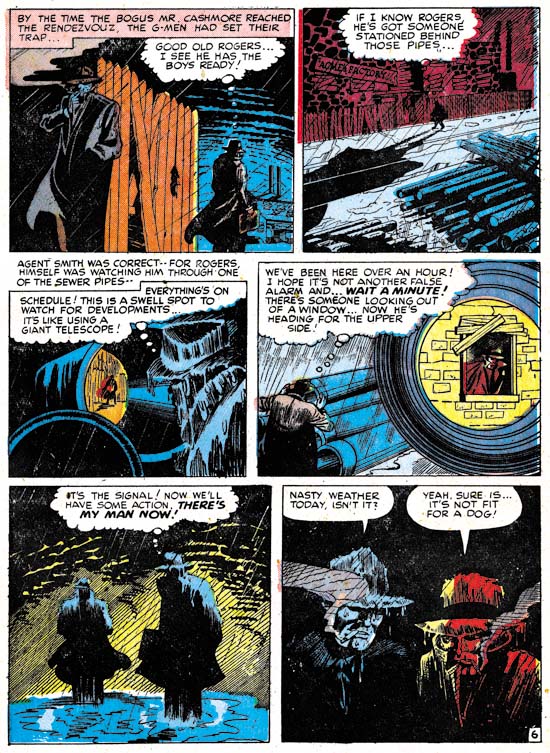
Headline #33 (December 1948) “Underworld Parasite” page 6, art by Manny Stallman
Although he did not seem to use predominately black panels in every story, there are a number of examples I could have selected. Perhaps page 6 “Underworld Parasite” is the best one. The drawing itself is not that exceptional, but the use of blacks makes this nighttime rendezvous very memorable.
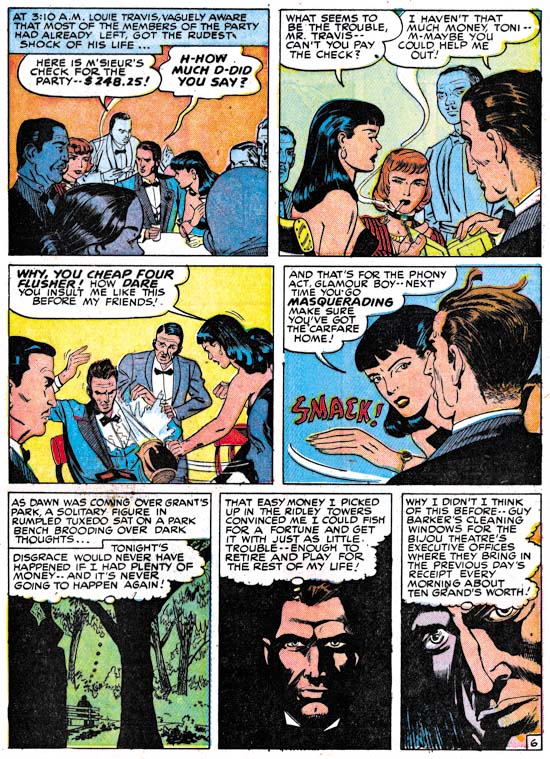
Headline #34 (February 1949) “Twenty Second Story Man” page 6, art by John Guinta and Manny Stallman
In my last installment of The Art of Romance I said I only knew of one work by the team of John Guinta and Manny Stallman for the S&K studio (“The Life of the Party”, Young Love #6, December 1949). I must not have checked my database because there was one other, “Twenty Second Story Man” shown above. (This time I double checked, these two are the only work by Guinta and Stallman in my database). I know little about John Guinta and a Google search did not provide much information. John Guinta’s pencils are distinctive; especially the eyebrows of woman, and it should not be hard to recognize unsigned work, if there is any, in the Simon and Kirby productions. It is interesting to compare Stallman’s inking of Guinta with that on his own pencils. Manny’s use of panels dominated by blacks shows up in “Twenty Second Story Man” as well.
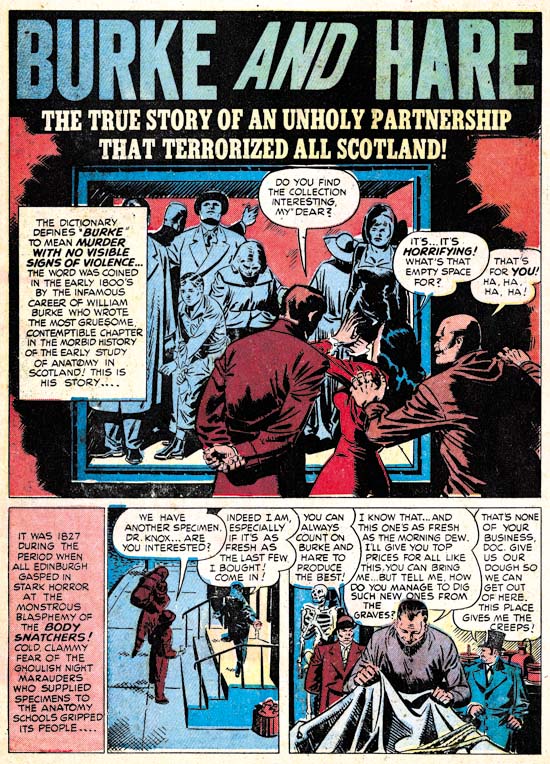
Justice Traps the Guilty #7 (November 1948) “Burke and Hare”, art by H. Colben?
I have included “Burke and Hare” because the artist’s signature is found in the last panel of the story. Unfortunately it is hard to make out the name but my best guess is H. Colben. That, however, does not help much because I have been able to find anything about an artist with that name so perhaps I have misread the signature. Colben is not the greatest of artists but he does have some distinctive features to his style and should be easy to determine whether he produced anything else for Simon and Kirby.

Headline #32 (October 1948) “The Clue of The Horoscope”, art by an unidentified artist
As I mentioned earlier, there are a number of stories that I have not been able to provide attributions. But there are a couple of stories, “Joe Slade, Wild West Jekyll And Hyde Desperado” (JTTG #8, January 1949) and “The Clue of the Horoscope”, by an artist I particularly wish I could identify. This artist uses what I would describe as a severe, sometimes even primitive, caricature style. As is seen often in Simon and Kirby productions, the splash panel shows aspects of the Studio style inking while the rest of the story is not. But there are other traits in the splash inking that deviates from the Studio style and agrees with the story inking. Most importantly the way some of the cloth folds are feathered is normally not an attribute of the Studio style. The picket fence crosshatching (see the Inking Glossary for an explanation of my inking terminology) has a hardness in its application that agrees with the inking found throughout the story. The best explanation for all this seems to be that the artist purposely adopted aspects of the Studio style so as to match better with other stories in the comic. It does seem that splash panels often are done in the Studio style.
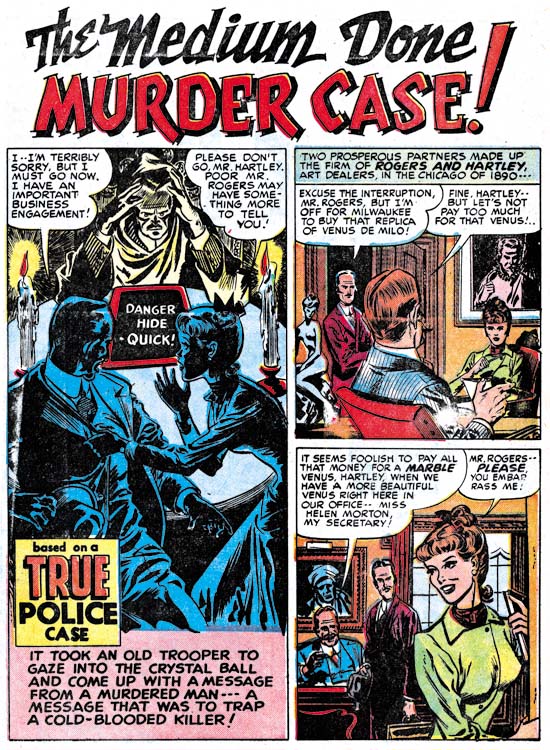
Headline #34 (February 1949) “The Medium Done Murder Case”, art by Leonard Starr
“The Medium Done Murder Case” is the earliest example of work by Leonard Starr for Simon and Kirby productions. It is unsigned but the style closely matches signed work by Starr. The women generally have an elfin look that is characteristic of Starr’s work for Simon and Kirby. Leonard would later produce a good amount of work for the western love titles (covered previously in The Art of Romance, Chapter 7) and some standard romance as well (The Art of Romance, Chapter 5). Starr signed much of his western love work but nothing in Simon and Kirby’s crime titles bears his signature. It will be interesting to see if further unsigned work can be found.
Chapter 1, Promoting Crime
Chapter 2, A Revitalized Title
Chapter 3, Competing Against Themselves
Chapter 4, Crime Gets Real
Chapter 5, Making a Commitment
Chapter 6, Forgotten Artists
Chapter 8, The Chinese Detective
Chapter 9, Not The Same
Chapter 10, The Master and His Protege
Chapter 11, The New Team

